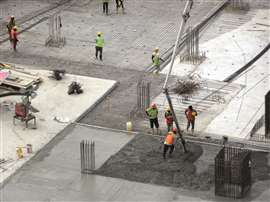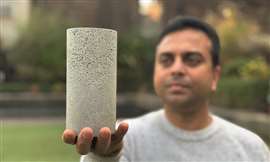The concrete sector is under pressure to evolve. Here’s how it’s responding.
21 August 2024
Still the second-most-used substance behind water, global concrete consumption is showing no signs of falling. However, as Mitchell Keller reports, the material isn’t what it once was, as the industry races to create more sustainable products.
The world population keeps growing, people keep on building, and – therefore – the concrete will keep pouring. By now, concrete’s permanence in the construction industry has long been solidified. But its binder – cement – is blamed for 5% to 10% of carbon-dioxide emissions worldwide and after more than one decade of intense research and scrutiny, concrete is changing.
Citing pressure from governmental regulations, public interest, and a steady rise in green investing, the concrete industry will need to find a way to reduce its cement use and carbon footprint.
To deliver on expectations, the industry is using an all-hands-on-deck approach in the pursuit of delivering a lower-emissions product.
There won’t be a singular unicorn product or process that suddenly puts global carbon-reduction plans into hyperdrive, but instead multiple innovations.
Manuel Toro, commercial chief officer for sustainability, digital strategy, and sales with Mexico-based building materials company Cemex, notes that, ultimately, customers want lower carbon-emissions and the industry is due to deliver as quickly as possible.
“For 2024, I think that I am excited about the speed that the industry is gaining towards a more sustainable one,” he says. “Many countries with high volumes of concrete are now more engaged in the sustainability trend and that’s something that definitely will impact our customers.”
 A construction worker lays Holcim’s prestressed, reusable concrete slabs for the Gruze Innovation Laboratory (Photo: Holcim Switzerland)
A construction worker lays Holcim’s prestressed, reusable concrete slabs for the Gruze Innovation Laboratory (Photo: Holcim Switzerland)
Replacing and altering cement
In finding a substitute for cement, it’s important to note that the industry means to replace, specifically, traditional Portland cement made from limestone, which is the most common type of cement used globally.
The calcination of limestone to make cement is also the biggest single releaser of carbon emissions during the process, with up to 50% of the industry’s emissions coming from this procedure. Eventually, it’s estimated that this traditional Portland cement blend will become extinct, but the term ‘cement’ and its basic purpose in the creation of concrete will remain.
Two of the most common materials replacing limestone are fly ash (a powdery byproduct from burning coal) and slag (a byproduct of smelting). Using both can limit the need for other materials and substances (like water and clinker) but also has some nuances that builders will need time to adjust to – literally.
Sara Neff, head of sustainability in America at Lendlease (an Australia-based construction and real-estate company), asserts that knowledge is power for planning projects with novel mixtures.
“We were told correctly the slag and fly ash would cause the concrete to cure more slowly,” she notes, referring to finished projects in the US.
It’s one component that can throw off even an experienced crew more familiar with conventional concrete. Weaker strength at initial placement for fly ash- and slag-based cement can extend a workday and lead to increased costs; a potential hinderance to universal adoption.
 Render of Lendlease’s 1 Java building project in Brooklyn, New York, US, which is pozzolan concrete in construction (Photo: Lendlease)
Render of Lendlease’s 1 Java building project in Brooklyn, New York, US, which is pozzolan concrete in construction (Photo: Lendlease)
But Neff adds the additional time is nominal, and it doesn’t have to be wasted if contractors and builders know how to manage it. “It’s maybe a little bit disconcerting for a little bit,” she acknowledges. “[But] we incorporated that into the schedule. We planned for it.”
Neff also notes strength and emissions-reduction successes with pozzolan – ground and recycled glass added to concrete mixtures – on several projects in the US.
“On our 1 Java project in Brooklyn, we replaced 40% of the cement in the foundation with a recycled glass product called ground glass pozzolan at no added cost to the project,” she said. “We worked with our concrete subcontractor and batch plant to procure, batch, and pour foundation concrete with Pozzotive, a ground glass pozzolan product made in the greater New York City region.”
Raising the reduction rates
In the last few years, carbon-emission reduction rates advertised up to 30% appeared to be the high end for emerging concrete products. In 2024, the bar has been set much higher, with some products advertising 80% emission-reduction.
One product in Cemex’s Vertua line of concretes and mixtures uses a proprietary geopolymer cement solution, which the company believes can reduce CO2 emissions by more-than or equal-to 60%. Davide Zampini, head of global research and development for Cemex, says more gains could be in the works.
 A large concrete pour in Kuala Lumpur, Malaysia (Photo: AdobeStock)
A large concrete pour in Kuala Lumpur, Malaysia (Photo: AdobeStock)
“There are clear indications that we can go above and beyond what we what are targeting,” he tells International Construction.
Just reducing or removing cement, too, is not enough, says Zampini. The whole process should be reconsidered with the goal of reducing emissions.
“For example, the grinding efficiency, the grinding energy,” he notes. “We can improve the level of substitution of clinker with supplementary symmetries and materials as we develop new technologies.”
What Zampini is describing is essentially a means to measure embodied carbon, which Neff adds has been underreported through the years. Measuring embodied carbon, she says, tracks carbon emissions created from making materials used in construction.
“We are measuring embodied carbon consistently on all our projects and in conceptual design,” she says. In this measurement, there is still a long way to go in terms of reductions, however. She says embodied carbon reductions on projects is levelling out with current products and processes around 30%.
“We’re just treading water,” Neff notes at 30% reduced embodied carbon, because concrete consumption increases every year – for example, around 3% in the US, alone.
Reusing concrete
The industry has been focused on reducing on a large scale, and has always had a market for recycling concrete, but what about reusing? A major hinderance to the substances’ carbon output is that reuse of concrete has been highly limited.
However, Switzerland-based Holcim – a construction materials and aggregates company – believes its carbon prestressed concrete solution could be a path forward.
“What if you could construct one of the world’s first carbon prestressed concrete (CPC) buildings and achieve significant CO2 and material savings, then dismantle its components for reuse elsewhere?” asks Holcim rhetorically.
It manufactures its CPC slabs, strengthened with prestressed carbon fibres in a factory environment. Using lightweight carbon fibre strands as a reinforcement gives the slabs the same load-bearing capacity as traditional reinforced concrete slabs while being up to five times thinner and lighter.
 Concrete pours from a mixer on-site (Photo: AdobeStock)
Concrete pours from a mixer on-site (Photo: AdobeStock)
Holcim used the slabs in the construction of its 120 square metre Grüze Innovation Laboratory, a company information centre and sustainable construction workshop. The building is constructed with Holcim’s ‘delicate but reusable’ concrete panels, which can be dismantled and reused.
The building – believed to be one of the first CPC buildings in the world – was constructed using a new method developed by Germany-based CPC and Zurich University of Applied Sciences.
Coupled with a ‘sharing’ programme (wherein a customer can loan the individual concrete panels), Holcim says the process lowers construction costs by up to 75%.
“It reduces the cost of a new development – since they don’t have to buy materials outright or dismantle the building,” explains the company. “Secondly, it gives them the option of assembling the structure elsewhere. Finally, the client can ask Holcim to disassemble the structure when it is no longer needed, so we can prepare the components for reuse.”
The celebrity connection
If there is any major takeaway regarding the concrete sector, it’s that it is no longer operating in the shadows. From corporate transparency to scientific data, there is no escaping concrete’s relevance and emission challenges. It simply must evolve.
Investment in the sector isn’t just coming from inside the industry; celebrities and professional athletes have been putting money down for a more sustainable product, which could lead to increased public attention, overall.
Take Partanna, the US-based sustainable concrete producer, which was co-founded by three-time National Basketball Association (NBA) champion Rick Fox, who also serves as the company CEO.
 Dr Chamila Gunasekara of RMIT holds a sample of low-carbon concrete (Photo: Michael Quin, RMIT)
Dr Chamila Gunasekara of RMIT holds a sample of low-carbon concrete (Photo: Michael Quin, RMIT)
The Canadian native and current Bahamas resident formed the company after a hurricane battered the islands in 2019. His goal: to find a more weather-resistant material for homebuilding.
Rory Anderson, chief growth officer for Partanna, said Fox was then inspired to lean into innovations that reduced the environmental impact. “He was looking for hurricane-proof housing solutions,” Anderson says, noting the mission has now doubled-down on being “nature positive”.
Partanna cures its concrete at room temperature, which requires less energy than using heat to cure. The material utilises brine, natural pozzolans, upscaled big industry waste and other proprietary ingredients to create its binder, which the company believes makes it carbon negative.
The product, Partanna says, also exhibits the ability to absorb CO2 from the atmosphere during the production process.
Fox isn’t the only celebrity intrigued by the concrete industry. Actor Dennis Quaid – through his digital content program Viewpoint – announced a series of episodes will feature sustainable technology innovations in building and architecture. The opening programme (titled “Green Building Materials”) is expected to highlight new eco-friendly construction products.
“Sometimes innovation has to come outside of the field,” says Anderson on why Hollywood and the pro sports community is suddenly actively involved in the industry and discussion. “And this is a huge problem. Up until recently, there haven’t been enough commercially scalable solutions to be able to create impact.”
He says the public, too, can see technology transform before their eyes from gas-powered cars of yesterday to electric/automated dump trucks of today. “But we’re still using the same materials to get to concrete,” he adds. “People, I think, are feeling that frustration and that there haven’t been solutions.
“There are massive pressures on the construction sector to decarbonise from a policy perspective, and I think that is driving a lot of the demand for innovation. People have looked at this as a sector and said, ‘What can I do?’”
For now, contractors and builders can keep building a diverse network of material and aggregates providers and continue their education on new concrete products. They’d be wise to keep up, as its some of the most advanced movement in a century that’s showing no signs of slowing.

